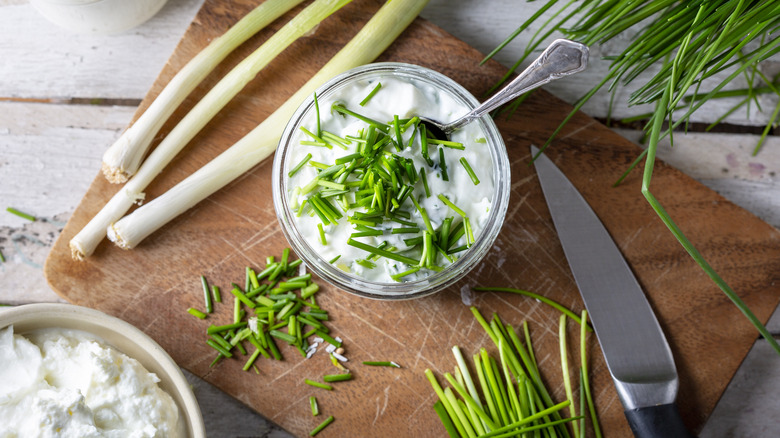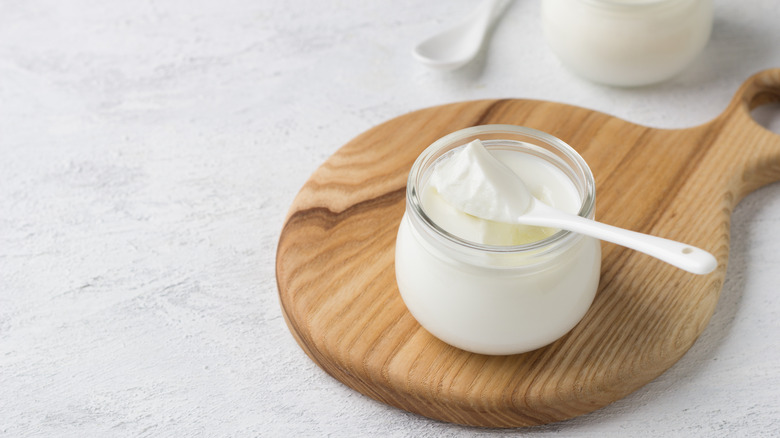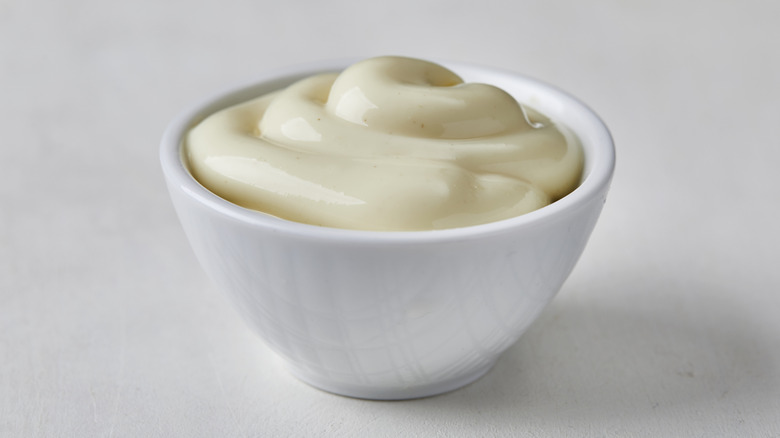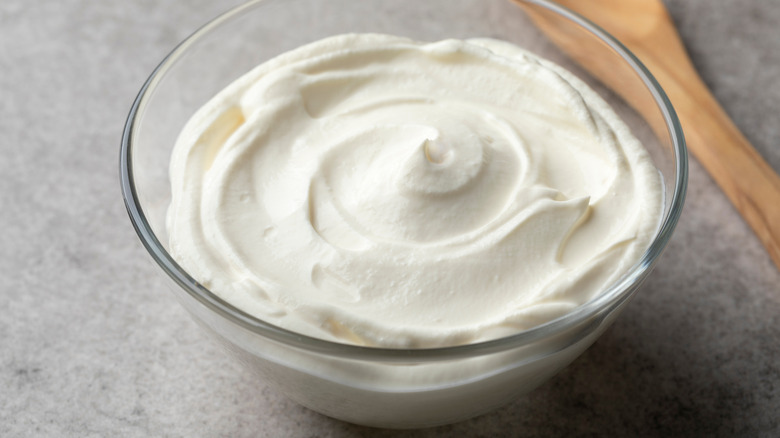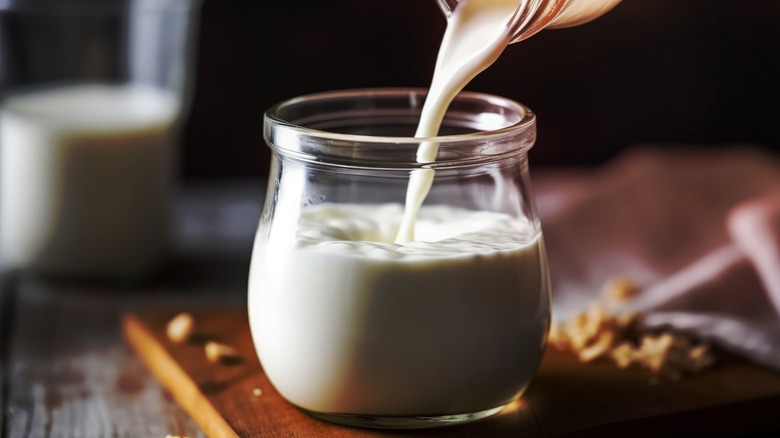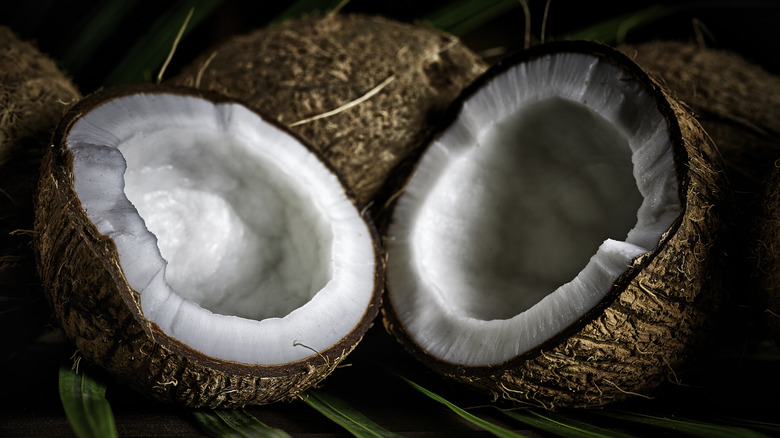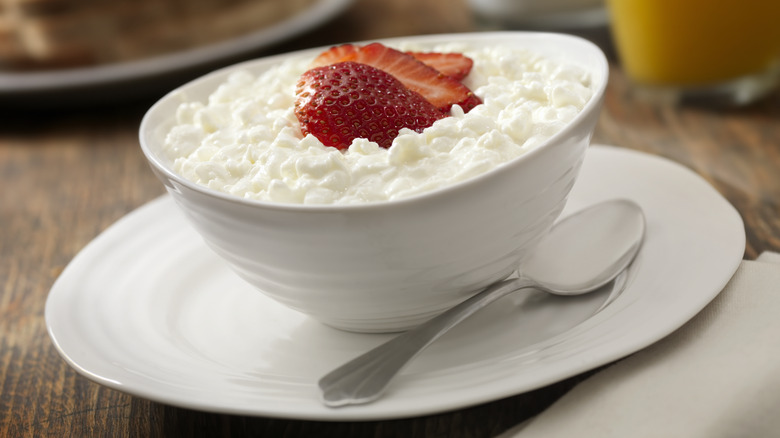3 Sour Cream Substitutes To Use And 3 To Skip
Ingredient swaps can be risky, but thankfully, swapping sour cream is pretty simple. There are a lot of suitable substitutes out there, but the best one will depend on your objectives. You must consider what purpose you'll be using the sour cream substitute for. Are you topping a crispy baked potato or baking a sour cream pound cake? You must also ask why you are making the swap in the first place. Are you simply out of sour cream, or do you need to meet a particular dietary need, like a vegan or lactose-free diet?
It also helps to know a bit about what sour cream actually is, and the process used to make it, so that you can figure out which potential substitutes are most closely in line with the real thing. Sour cream is made by combining heavy cream with lactic acid bacteria and allowing it to ferment. You can actually replicate this in your own kitchen using vinegar in place of lactic acid. Now, that would be an awfully roundabout way to make a substitute for store-bought sour cream, so here are three easy options worth trying, and three you should avoid.
Use: Greek yogurt
Greek yogurt is the all-around best substitute for sour cream because it's very similar to the real thing, and can be used in all the same scenarios. Yogurt and sour cream are actually made via the same process of lactic acid fermentation, except yogurt is made with milk instead of cream. This means that yogurt has a lower fat percentage, typically around 10-12%, compared to sour cream, which is typically about 20% fat. To account for this, it's important that you use full-fat Greek yogurt, and you can even add a splash of heavy cream to more closely match the richness and smoothness of sour cream.
Unlike other types of yogurt, Greek yogurt has the whey strained out of it, which gives it a thick, creamy texture similar to sour cream. Other types of yogurt are more thin and milky, so while you could potentially use them in place of sour cream for certain baking needs, they won't work well for purposes like topping tacos. However, you can strain regular yogurt through a coffee filter or cheesecloth to separate the whey. Of course, it's essential to use plain, unflavored yogurt, and make sure it contains no artificial thickeners.
Skip: mayonnaise
Sour cream and mayonnaise have a similar color and texture, but that's about where their similarities end. Mayonnaise is made from completely different ingredients than sour cream — eggs and oil — so their culinary properties don't really align. The big problem you have to contend with is that mayonnaise is significantly fattier than sour cream. It contains 70-80% fat compared to sour cream's 20%. This means that using mayo in place of sour cream for dips, dressings, or condiments can make the food overly rich, and it won't have quite the same mouthfeel.
Mayonnaise presents an even bigger issue in baking. There are three main reasons to use sour cream in baked goods. First, it provides moisture; second, it provides fat for a rich flavor and mouthfeel; and third, it provides acid, which softens the gluten in baked goods and serves as the activating agent for baking soda. Mayonnaise can provide moisture and fat (sometimes too much fat, as previously noted), but it isn't acidic enough to activate baking soda. Without a strong acid component in your recipe, baked goods made with baking soda won't rise. You'd be much better off using the next sour cream substitute on this list.
Use: crème fraîche
Admittedly, the odds of anyone having crème fraîche on hand (but not sour cream) probably aren't the highest. It's hardly an everyday item in the average household, and it's a good deal more expensive than sour cream, too. However, if you do happen to have some crème fraîche available, it's pretty much the perfect sour cream substitute; and in certain cases, may be even better than the real thing.
Crème fraîche is almost identical to sour cream, both being made from fermented cream. The difference is that crème fraîche is made with fattier cream (around 30% fat compared to sour cream's 20%) and is not quite as acidic. You can up the acid by adding a squeeze of lemon or lime juice to your recipe, but even then, it might not be the best substitute for baked goods. On the other hand, crème fraîche is actually better than sour cream at thickening creamy sauces and soups because it doesn't curdle as easily.
Skip: buttermilk
Buttermilk can actually be a decent substitute for sour cream in baked goods, but that's about it. Buttermilk has a similarly tangy flavor profile to sour cream, but with an average fat percentage of about 1%, buttermilk is actually less fatty than most milk, and leagues below sour cream. Then, there's the obvious problem of consistency. Buttermilk is very thin and runny, so it can't pass for sour cream as a condiment, or an ingredient in sauces or dips.
Some bakers do favor buttermilk as a substitute for sour cream because it contains the right level of acid. Both buttermilk and sour cream average around 4.5 on the pH scale. In baking, you can get around the issue of consistency by using ¾ of a cup of buttermilk for every cup of sour cream the recipe calls for. It's a risky swap though, because you'll still be missing out on the essential fat factor, which does so much for both flavor and texture.
Use: coconut cream
If you're looking for a vegan or lactose-free sour cream substitute, coconut cream is the move. It's like coconut milk, but with a higher ratio of coconut to water, making it thicker and creamier. If you've ever opened a can of coconut milk and found it has a thick creamy top layer, that's coconut cream. Skim it off and mix in some lemon juice (1 tablespoon for each cup of coconut cream) to give it that crucial acidity, and you should be good to go.
You can also buy cans of straight coconut cream, so you can get a lot more of it without the effort of skimming and straining cans of coconut milk. It's a smart pantry staple in any dairy-free household. Once you've mixed it with lemon juice, coconut cream is ready to use in any of the applications you'd normally use sour cream for, including dressings, dips, and baked goods. Keep in mind that it will carry some coconut flavor with it though, so you should consider whether that will pair well with the other elements of your dish.
Skip: any kind of cheese
A lot of sites recommend substituting cream cheese, cottage cheese, or mascarpone for sour cream, but you'd be better off choosing none of the above. It is possible to make fresh cheeses like these work as a sour cream substitute, but it takes a lot of fussing around to pull it off. Cream cheese and mascarpone are much thicker than sour cream, so you need to thin them out by mixing them with milk or cream. They're not tangy enough either (in fact, mascarpone is rather sweet), so you'll need to add lemon juice as well.
Cottage cheese is even more frustrating as a sour cream substitute. It's not tangy enough, so again, you'll need to add lemon juice, but you'll also need to dirty a bunch of extra dishes to fix the texture. Cottage cheese is lumpy, so you'll need to run it through a blender or food processor in order to smooth it out. At that point, it might be easier to just go to the store and get sour cream.
